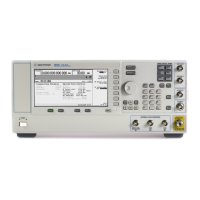128 Chapter 3
Basic Digital Operation
Setting the Baseband Frequency Offset
Setting the Baseband Frequency Offset
The baseband frequency offset specifies a value to shift the baseband frequency up to ±20 MHz
within the BBG 80 MHz signal bandwidth, depending on the signal generator’s baseband generator
option.
When the Baseband Frequency Offset is non–zero, the hardware rotator accumulates phase–shift of
the baseband signal. This phase is automatically reset when the baseband frequency offset is returned
to 0 Hz.
Common uses for the offset feature include:
• offsetting the carrier from any LO feedthrough (carrier signal spur at the carrier frequency)
• sum the baseband signal with external I and Q inputs to create a multicarrier signal
• use the signal generator’s I/Q signal as an IF
NOTE Changing the baseband frequency offset may cause a DAC over range condition that
generates error 628, Baseband Generator DAC over range. The signal generator
incorporates an automatic scaling feature to minimize this occurrence. For more information,
see “How Scaling Eliminates DAC Over–Range Errors” on page 126.
The baseband frequency offset value is one of the file header parameters, which means you can store
this value with the waveform. When you select a waveform with a stored frequency offset value, the
signal generator changes the current value to match the stored file header value. If there is no stored
baseband offset frequency value for the current waveform, the signal generator uses the last set
frequency offset value.
You can also use the Save function to store this value as part of the signal generator setup. When
you Recall a setup stored with the Save function, the baseband frequency offset value becomes the
current instrument setting value, disregarding the stored file header value.
Use the following steps to offset the carrier from LO/carrier feedthrough. This example uses the
factory supplied waveform, SINE_TEST_WFM available in the Dual ARB Player. To view the output for
this example, connect the RF OUTPUT of the signal generator to the input of a spectrum analyzer.
1. Select and play the waveform.
a. Press
Mode > Dual ARB > Select Waveform.
b. In the main display highlight the waveform: SINE_TEST_WFM.
c. Press
Select Waveform.
2. Generate the waveform: Press
ARB Off On to On.
3. Configure the carrier signal:
a. Set the carrier signal to 1 GHz.
b. Set the amplitude to 0 dBm.
c. Turn on the RF OUTPUT.
4. Press
ARB Setup > More (2 of 3) > Baseband Frequency Offset > 20 MHz.
The modulated RF signal is now offset from the carrier frequency by 20 MHz.

